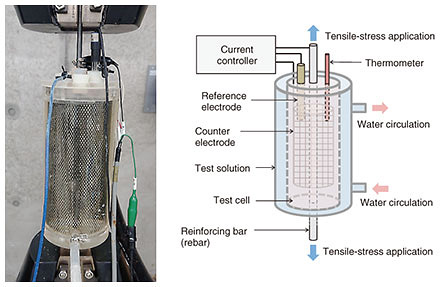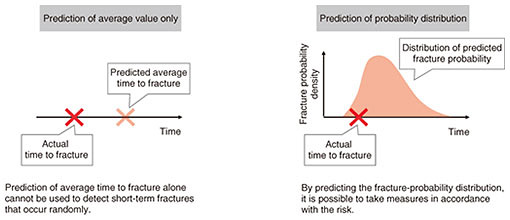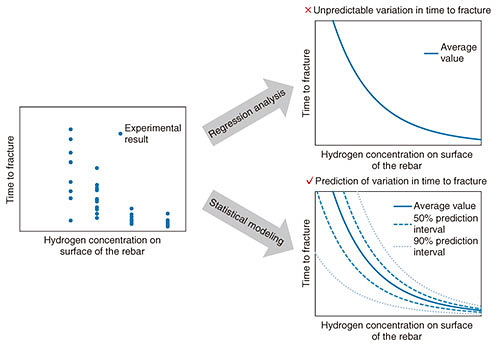 |
|||||||
|
|
|||||||
|
Feature Articles: Healthcare Devices and Infrastructure-maintenance Technology that Support People and Society Vol. 19, No. 6, pp. 66–70, June 2021. https://doi.org/10.53829/ntr202106fa10 Technology for Predicting Hydrogen Embrittlement in Reinforcing Bars of Concrete PolesAbstractA concrete pole, which is an important part of the communication infrastructure supporting communication services, requires significant maintenance costs to ensure its safety. If hydrogen embrittlement, a phenomenon by which reinforcing bars in concrete poles deteriorate, could be accurately predicted, it would be possible to maintain and manage concrete poles more safely and economically. A technology for predicting hydrogen embrittlement in reinforcing bars inside concrete poles that involves using an accelerated-hydrogen-embrittlement test and statistical data analysis is introduced. Keywords: hydrogen embrittlement, deterioration prediction, concrete pole 1. Maintenance of concrete polesA concrete pole is an important part of the communication infrastructure supporting communication services in Japan. If a concrete pole breaks, it may lead to property damage or personal injury; accordingly, all concrete poles are systematically maintained and managed so that they do not deteriorate. Maintaining concrete poles in this manner incurs a huge cost, so an economical maintenance technology that also ensures safety is required. Pre-stressed concrete is used to suppress cracks in concrete poles. Such concrete is formed by applying tensile stress to the reinforcing bars (rebars) in advance. This shrinks the rebars and applies compressive stress to the concrete, which suppresses crack generation. Rebars used in pre-stressed concrete do not exhibit any problems under normal usage conditions. However, a deterioration phenomenon called hydrogen embrittlement can progress when various adverse conditions are combined [1–3]. Since the strength of concrete poles is secured by the internal rebars, deterioration of the rebars could lead to breakage of the concrete poles. If hydrogen embrittlement of rebars in concrete poles could be accurately predicted, inspections and repairs based on the predicted risk of deterioration would be possible; as a result, concrete poles could be maintained and managed more safely and economically. Given this possibility, we are pursuing research and development to establish a technology for predicting hydrogen embrittlement of rebars in concrete poles. 2. Hydrogen-embrittlement-prediction technologyHydrogen embrittlement is a phenomenon in which atomic hydrogen (i.e., individual hydrogen atoms) penetrates a metallic material under tensile stress, reducing its strength and causing cracks and fractures in the material. It is sometimes called delayed fracture because the metallic material breaks after a certain period after hydrogen invades it under a constant load. Since the rebars used in pre-stressed concrete are constantly subjected to tensile stress, hydrogen embrittlement due to intrusion of hydrogen is a constant risk. The interior of concrete is normally an alkaline environment, so corrosion of rebars rarely occurs; however, when cracks occur in concrete, the concrete around the cracks are neutralized by carbon dioxide in the air, and rainwater that has penetrated the concrete via the cracks can corrode the rebars. When rebars corrode in this manner, hydrogen is generated, penetrating the rebars and causing hydrogen embrittlement. Therefore, the environmental factors that cause hydrogen embrittlement of rebars in pre-stressed-concrete are being investigated. The mechanism of hydrogen embrittlement remains unclear. It is therefore considered difficult to predict hydrogen embrittlement by using a deductive method based on the hydrogen-embrittlement mechanism. By conducting tests to reproduce hydrogen embrittlement in a neutralized concrete environment and investigating the behavior of hydrogen embrittlement, we are attempting to predict hydrogen embrittlement by using an inductive method based on data analysis. In the future, it will be possible to make predictions with deductive methods by deepening our understanding of the hydrogen-embrittlement mechanism; in other words, we are aiming for a virtuous cycle in which the prediction accuracy of an inductive method is further improved using the results from a deductive method. When reproducing hydrogen embrittlement, it is assumed it takes a long time to occur in an actual environment. To shorten that time, we are using an accelerated test that increases hydrogen concentration in a rebar to quickly cause fracture by hydrogen embrittlement. The external appearance and a schematic diagram of the accelerated-hydrogen-embrittlement test are shown in Fig. 1. In the test, hydrogen embrittlement in a neutralized concrete environment is simulated as follows: (i) a rebar is immersed in a weak-alkaline test solution inside a test cell (to reproduce a neutralized concrete environment); (ii) a tensile tester is used to apply a pre-determined tensile stress to the rebar (to reproduce the pre-stress applied to the rebar); and (iii) an electric current is passed through the rebar to generate hydrogen by electrolysis of water (to reproduce hydrogen generation due to corrosion). Since the amount of hydrogen generated can be controlled by adjusting the magnitude of the electric current, the hydrogen concentration in the rebar is increased by generating a sufficiently larger amount of hydrogen than that in an actual environment, accelerating hydrogen embrittlement. By conducting the accelerated-hydrogen-embrittlement test to determine the relationship between hydrogen concentration and fracture time/probability and extrapolating that relationship to the hydrogen concentration in an actual environment, we are attempting to predict hydrogen embrittlement in an actual environment.
3. Estimating time to fracture and fracture probability by conducting the accelerated-hydrogen-embrittlement testHydrogen embrittlement of rebars is known to vary greatly in time to fracture even under uniform environmental conditions. For general regression analysis, only the average time to fracture can be predicted, and predicting only this average cannot be done to detect short-term fracture that occurs randomly. If the probability distribution of time to fracture could be predicted, it would be possible to detect fractures with shorter times to fracture than the average in accordance with the risk fracture (Fig. 2). Accordingly, we are attempting to predict time to fracture (including its probability distribution) by using statistical modeling for a large amount of time-to-fracture data acquired from the accelerated-hydrogen-embrittlement test.
Two conclusions can be drawn from the results of the accelerated-hydrogen-embrittlement test: (i) the relationship between hydrogen concentration on the surface of a rebar and the average time to fracture can be approximated by an exponential function and (ii) the variation in time to fracture at uniform hydrogen concentration follows the Weibull distribution. By creating a statistical model from these results and using the maximum-likelihood method for the time-to-fracture data, the relationship between hydrogen concentration and the probability distribution of time to fracture can be estimated. The maximum-likelihood method is used to estimate the parameters of probability distributions other than normal distributions such as a Weibull distribution. Regarding the maximum-likelihood method, the parameters are estimated from the acquired data by searching for the parameters that maximize the infinite product (likelihood) of the probability density of the acquired data. Examples of time-to-fracture data obtained from the accelerated-hydrogen-embrittlement test, estimated average values only from regression analysis, and estimation results (including the probability distribution) obtained using statistical modeling are shown in Fig. 3. It is clear from these results that using statistical modeling makes it possible to estimate not only the average time to fracture but also its probability distribution.
When exposed to a certain environmental condition, some rebars fracture due to hydrogen embrittlement after a certain time and others do not no matter how much time passes, and the occurrence or non-occurrence of future fracture can be expressed as a fracture probability. When the tensile stress applied to a rebar or the hydrogen concentration on the surface of the rebar increases, the fracture probability increases. When the tensile stress or hydrogen concentration becomes sufficiently low, however, the fracture probability becomes almost zero. When considering the maintenance of concrete poles, we must also consider the importance of the fracture probability of rebars due to hydrogen embrittlement. It is understood from the results of the accelerated-hydrogen-embrittlement test that the relationship between hydrogen concentration on the surface of a rebar and fracture probability can be approximated with a sigmoid curve. It thus follows that the relationship between hydrogen concentration and fracture probability can be estimated using logistic regression analysis, which is a means of estimating the probability of an event occurring when a binary variable (namely, whether a certain event occurs) is taken as the objective variable. A logistic function is used in logistic regression analysis as a regression model, and the parameters of the logistic function are estimated using the maximum-likelihood method. We conducted the accelerated-hydrogen-embrittlement test under variable tensile stress, hydrogen concentration on the surface of a rebar, and temperature and estimated the fracture probability from the acquired data on occurrence or non-occurrence of fracture. The relationship between hydrogen concentration on the surface of a rebar and fracture probability when tensile stress and temperature were fixed is shown in Fig. 4. In this analysis, the case in which the rebar fractures during the accelerated-hydrogen-embrittlement test is defined as “1” and that in which it does not fracture is defined as “0,” and the regression curve of fracture probability and the 95%-confidence intervals are estimated from logistic regression analysis. Therefore, the relationship between hydrogen concentration on a rebar surface and future fracture probability can be estimated from the fracture occurrence or non-occurrence data obtained from the accelerated-hydrogen-embrittlement test.
4. Future developmentsBy extrapolating the relationship between hydrogen concentration, time to fracture, and fracture probability obtained from the accelerated-hydrogen-embrittlement test to include the hydrogen concentration in an actual environment, it will be possible to predict the time to fracture and fracture probability of rebars in concrete poles. The estimated surface-hydrogen concentration of rebars in a standard real environment will be used for extrapolation, and by constructing a new measurement system for detecting hydrogen that has entered a rebar, we plan to acquire the surface-hydrogen-concentration data for rebars that are required for estimation. To verify the prediction results, we also plan to continue research—in collaboration with universities—on modeling the hydrogen-embrittlement mechanism from the viewpoint of materials science. References
|
|||||||















